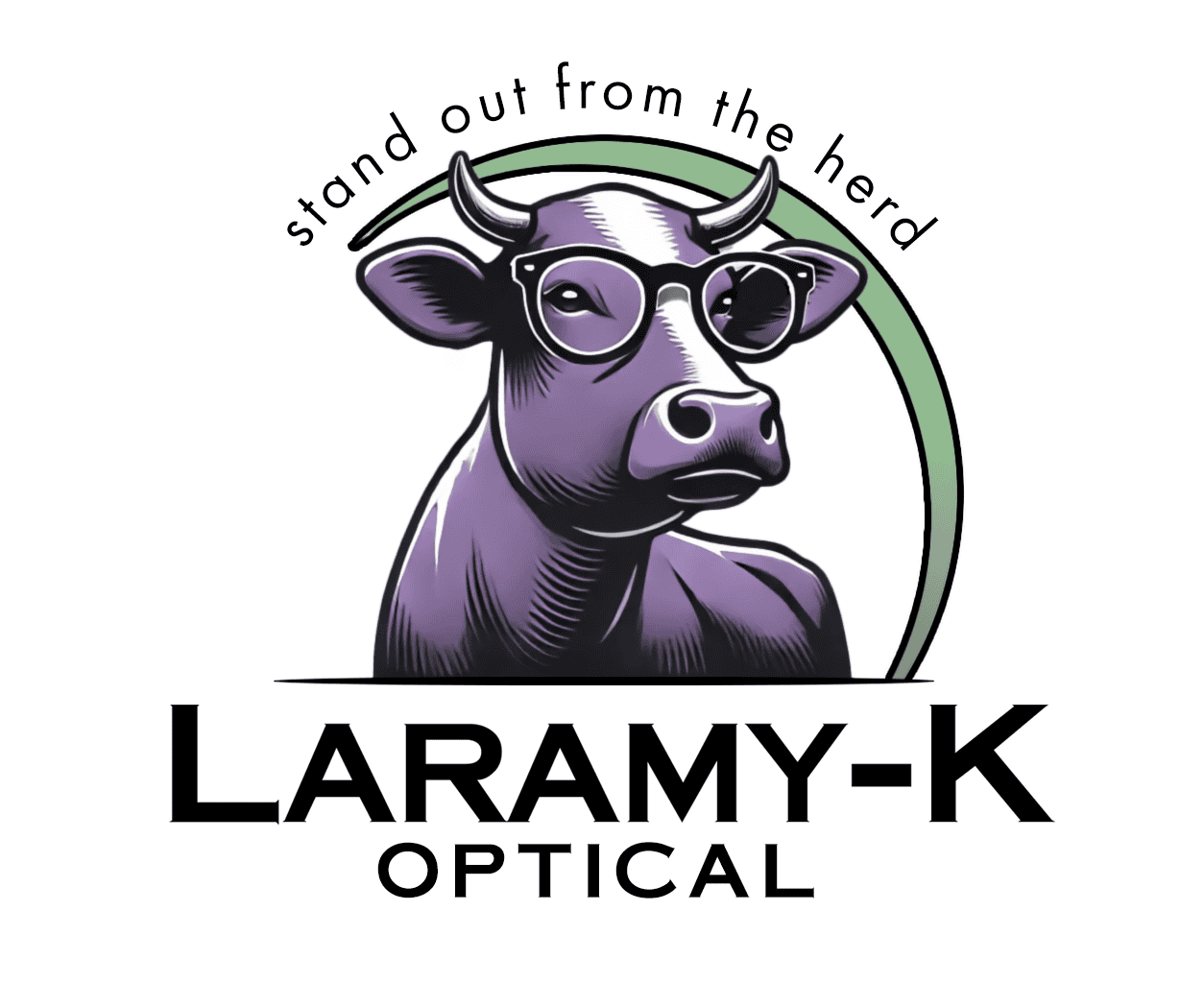In the realm of vision correction, eyeglass lenses are not one-size-fits-all. To cater to the diverse visual needs of individuals, lenses are available in various types such as single vision, bifocal, trifocal, progressive, freeform progressive, and more. Each type is uniquely designed to address specific vision issues, ensuring that everyone from those with basic vision correction needs to those with more complex visual requirements can find an effective solution.
Single-Vision Lenses
Single vision lenses, as the name suggests, correct a single refractive error with a single focal length throughout the entire lens. They are specifically designed to address a single vision issue, such as nearsightedness (difficulty seeing distant objects clearly), farsightedness (difficulty focusing on close objects), or astigmatism (distorted vision due to an irregularly shaped cornea or lens). Minus powered single vision lenses are used to correct myopia and plus powered single vision lenses are used to correct hyperopia. Single vision lenses can also be used as reading glasses for presbyopic patients who have clear distant vision, but require correction for close objects.
Detailed Insights
- Uniform Power: Consistent correction strength across the lens.
- Ideal for Specific Activities: Customized for tasks like reading or computer work.
- Affordability: Generally more cost-effective than multifocal lenses.
- Wide Field of Vision: Offers a broad, distortion-free viewing area.
Bifocal Lenses
As people age, the lens of the eye tends to harden, resulting in a lessening of the ability to focus on near objects. This condition is known as presbyopia. As presbyopia sets in, if an individual has an existing refractive error, two refractive corrections may become necessary; one for near and one for distance. To accommodate two refractive corrections, bifocals can be used. In a bifocal, the bulk of the lens is used to compensate for the existing refractive error, while a plus correction or add power segment is included in the lower portion of lens, where people already tend to look to view near objects (such as when reading a book), to correct for the presbyopic condition.
Bifocal lenses are divided into two distinct sections: the upper part for distance vision and a lower segment for near vision. The demarcation between these two zones is a visible line on the lens. Bifocals are traditionally used by individuals who have developed presbyopia (age-related difficulty in focusing on close objects) but still require distance vision correction.
Common types of bifocal lenses include: round segment, which has a circular add segment of the lower portion of the lens; flat top, which has a semi-circular add segment; and executive, which uses the entire lower portion of the lens for the add segment. Add segments are available in many different sizes to accommodate a patient's needs and frame requirements.
Detailed Insights
- Dual-Power Zones: Distinct areas for near and far vision.
- Visible Line: Demarcation can be noticeable and may require visual adaptation.
- Presbyopia Correction: Specifically beneficial for individuals over 40.
- Wide Field of Vision: Wearers have edge-to-edge distortion free viewing in each zone.
Trifocal Lenses
As presbyopia advances, depending on the patient's activities and lifestyle, there may be a need for intermediate distance refractive correction, in addition to the near correction. Trifocals include an intermediate range add segment on top of near range add segment to accommodate the patient's multi-focal requirements. Trifocal lenses incorporate three distinct viewing zones for near, intermediate, and distance vision, each separated by visible lines. The additional intermediate zone is typically positioned above the near-vision segment and is designed for tasks at arm's length, like computer use.
Trifocals are commonly available in flat top and executive styles. Like bifocals, trifocals segments are available in many sizes and heights to accommodate a patient's needs and frame requirements.
Detailed Insights
- Three Levels of Correction: Addresses near, intermediate, and far vision.
- Visible Lines: More pronounced than bifocals, with two lines instead of one.
- Intermediate Vision: Ideal for activities like computer work.
- Wide Field of Vision: Wearers have edge-to-edge distortion free viewing in each zone.
Progressive Lenses
Progressive lenses offer a gradual transition between different focal powers for near, intermediate, and distance vision, all within a single lens. Unlike bifocals or trifocals, progressives have no visible lines, providing a more natural visual experience. The lens power changes smoothly from the top (distance) to the bottom (near) of the lens.
Detailed Insights
- Seamless Transition: No visible lines separating different vision zones.
- Natural Visual Experience: Mimics natural eyesight with a smooth power gradient.
- Fitting and Adaptation: Requires precise measurement and some wearers may need time to adapt.
Freeform Progressive Lenses
Freeform progressive lenses represent a significant advancement in progressive lens technology. Utilizing precise manufacturing techniques, these lenses are customized at a much higher level of detail compared to traditional progressive lenses. Freeform progressives are crafted using computer-controlled surfacing equipment that can sculpt the lens surface with extreme precision. This allows for customized lens designs that can be tailored to an individual's specific vision needs, frame choice, and even viewing habits.
Detailed Insights
- Advanced Customization: Freeform technology enables a personalized vision solution, taking into account unique aspects such as the wearer's prescription, pupillary distance, and the specific frame's geometry.
- Improved Visual Clarity: These lenses offer a wider field of vision, reduced distortion, and greater clarity across all viewing zones - near, intermediate, and far.
- Tailored to Lifestyle: The lens design can be optimized based on the wearer’s lifestyle, occupational needs, and visual habits, offering a bespoke vision correction experience.
- High-Precision Manufacturing: Utilizes sophisticated equipment for lens crafting, resulting in highly accurate and individualized lens power distribution.
- Seamless Transition: Provides a smooth progression between different focal lengths, enhancing the comfort of transitioning from one viewing zone to another.
Freeform progressive lenses stand out as a pinnacle of personalized vision correction. They offer a level of customization and visual performance that goes beyond traditional lens crafting methods, making them an excellent choice for those seeking superior clarity and comfort in their progressive lenses.
Freeform Progressives with Camber Technology
Freeform Progressive lenses with Camber Technology take progressive lens design a step further. Camber Technology integrates a unique, continuously changing front surface curvature into the lens. This allows for a more expanded reading area and improved peripheral vision compared to traditional progressive lenses. Learn more about Camber Lens Technology,
Detailed Insights
- Innovative Curvature: Camber Technology uses a variable base curve, improving the lens optics for a wider field of vision.
- Enhanced Peripheral Vision: Reduces the 'swim effect' often associated with progressive lenses, offering clearer peripheral vision.
- Expanded Reading Area: Provides a broader and more comfortable reading zone, easing the transition between different viewing distances.
- Customizable Design: Freeform technology allows for personalization based on the wearer's prescription, frame choice, and viewing habits.
- Reduced Distortion: Minimizes distortions and aberrations, particularly in the intermediate and near regions of the lens.
- Flatter Lenses: Allows the laboratory to select flatter base curves while still giving the wearer the curve they need for maximizing their near vision zone.
Freeform Progressives with Camber Technology bridge the gap between visual needs and lens functionality, offering a superior solution for progressive lens wearers. By leveraging this advanced technology, opticians can provide their clients with progressive lenses that offer not only clearer vision but also greater comfort and a more natural visual experience.
Anti-fatigue Lenses
Anti-fatigue lenses are primarily single-vision lenses with a slight addition of magnifying power in the lower portion. This design helps to reduce eye strain associated with close-up tasks, particularly for individuals who spend extensive time on digital devices or doing fine detailed work.
Detailed Insights
- Magnification Support: Lower part of the lens eases eye muscle effort.
- Targeted for Digital Eye Strain: Reduces fatigue from prolonged screen exposure.
- Ideal for Intensive Near-Work: Aids in comfort during extended reading or computer use.
Occupational Lenses
Occupational lenses are tailored to suit the specific professional or recreational needs of individuals, particularly presbyopic patients. These lenses are customized based on the dominant visual tasks of a person's occupation or hobbies. For instance, someone who frequently uses a computer may need the major part of their lens, typically allocated for distance vision, to be adjusted for intermediate range correction. Similarly, an individual whose job involves looking at objects overhead might require an additional segment in the upper portion of the lens for near vision.
Detailed Insights
- Customized Design: Adapted to suit specific visual demands of different occupations or activities.
- Variety of Styles: Available in multiple designs to accommodate various work environments.
- Intermediate Distance Focus: Ideal for tasks such as computer work, where intermediate vision is prioritized.
- Upper Segment Addition: Beneficial for jobs requiring frequent upward viewing of close objects.
- Lab Consultation: Opticians should collaborate with their lens lab to explore available options and find the best fit for their clients' occupational needs.
Occupational lenses represent a specialized area of vision correction, where the focus shifts from general vision enhancement to specific, task-oriented visual support. By understanding the unique designs and purposes of these lenses, opticians can effectively cater to the nuanced visual requirements of their clients' professional and recreational lives.

